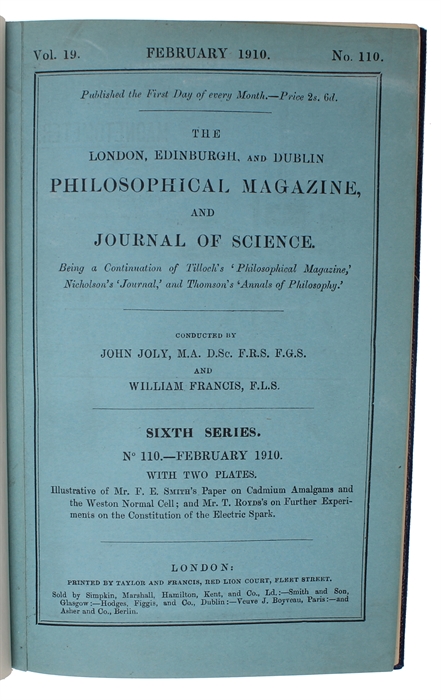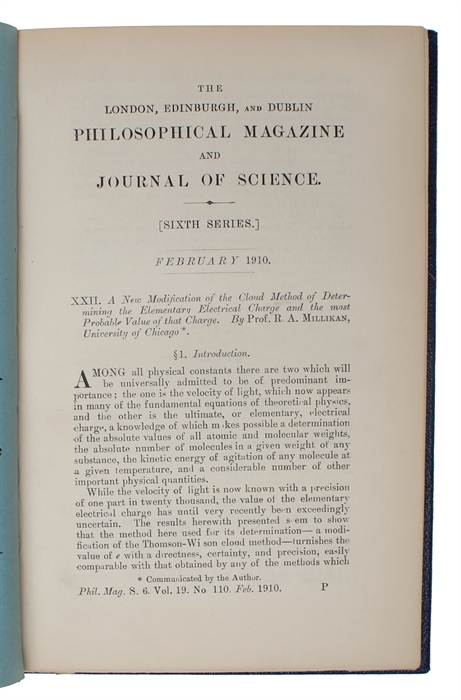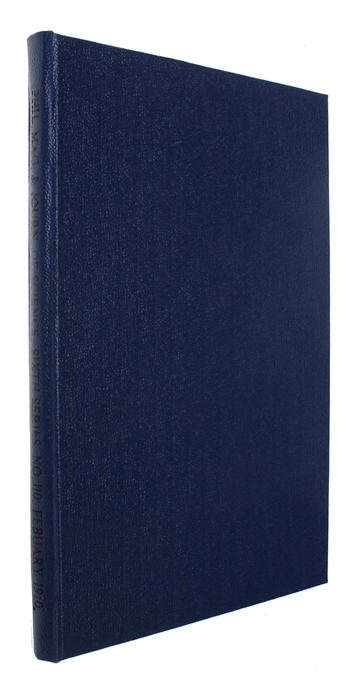THE OIL DROP EXPERIMENT
MILLIKAN, R. A.
A New Modification of the Cloud Method of Determining the Elementary Electrical Charge and the Most Probable Value of that Charge.
London, Taylor & Francis, 1910.
8vo. Bound with the original wrappers in recent full blue cloth with black lettering to spine. In "The Philosophical Magazine" for February 1910, vol 19, no. 110. The entire issue offered. Wrappers reinforced in margin, otherwise a fine copy. Pp. 209-228 [Entire issue: pp. 209-336].
First edition of Millikan's landmark experiment in which he first provided the definitive proof that all electrical charges are exact multiples of a definite, fundamental value, namely the charge of the electron which in essence made possible the measurement of the electrical charge. In this paper, Millikan makes "the important discovery that individual drops always carried an exact multiple of the smallest charge measured - this being the first accurate measurement of the charge of the electron" ( Davis, Science in the Making, Volume 3, 10-11). Today it is primarily known as the 'oil-drop experiment'. In 1923 Millikan became the first American-born Nobel laureate for his work on determination of Planck's constant on the basis of Einstein's theory of the photoelectric effect.
"By 1909 Millikan was deeply involved in an attempt to measure the electronic charge. No one had yet obtained a reliable value for this fundamental constant, and some antiatomistic Continental physicists were insisting that it was not the constant of a unique particle but a statistical average of diverse electrical energies. Millikan launched his investigation with a technique developed by the British-born physicist H. A. Wilson; it consisted essentially of measuring, first, the rate at which a charged cloud of water vapor fell under the influence of gravity and then the modified rate under the counterforce of an electric field. Using Stokes's law of fall to determine the mass of the cloud, one could in principle compute the ionic charge. Millikan quickly recognized the numerous uncertainties in this technique, including the fact that evaporation at the surface of the cloud confused the measure of its rate of fall. Hoping to correct for this effect, he decided to study the evaporation history of the cloud while a strong electric Held held it in a stationary position.
But when Millikan switched on the powerful field, the cloud disappeared; in its place were a few charged water drops moving slowly in response to the imposed electrical force. He quickly realized that it would be a good deal more accurate to determine the electronic charge by working with a single drop than with the swarm of particles in a cloud. Finding that he could make measurements on water drops for up to forty-five seconds before they evaporated. Millikan arrived at a value for e in 1909 which he considered accurate to within 2 percent. More important, he observed that the charge on any given water drop was always an integral multiple of an irreducible value. This result provided the most persuasive evidence yet that electrons were fundamental particles of identical charge and mass.
Late in 1909 Millikan greatly improved the drop method by substituting oil for water. Because of the relatively low volatility of this liquid, he could measure the rise and fall of the drops for up to four and a half hours. Spraying the chamber with radium radiation, he could change the charge on a single drop at will. His overall results decisively confirmed the integral-multiple values of the total charge. As for the determination of e itself, Millikan found that Stokes's law was inadequate for his experimental circumstances because the size of the drops was comparable with the mean free path of the air. Using the so-called Stokes-Cunningham version of the law, which took this condition into account, by late 1910 he had computed a charge for e of 4.891×10-10 e.s.u. Realizing that the accuracy of this figure was no better than that of the key constants involved in the computation, Millikan painstakingly reevaluated the coefficient of viscosity of air and the mean-free-path term in the Stokes-Cunningham law. In 1913 he published the value for the electronic charge, 4.774±.009×10-10 e.s.u., which would serve the world of science for a generation." (DSB).
Order-nr.: 60036



